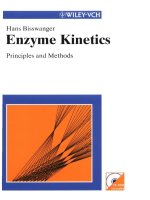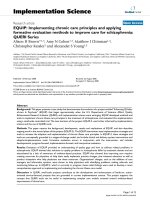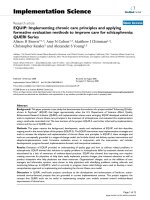Project evaluation principles and methods
Bạn đang xem bản rút gọn của tài liệu. Xem và tải ngay bản đầy đủ của tài liệu tại đây (242.94 KB, 34 trang )
Chapter 5
Project Evaluation:
Principles and Methods
Copyright 2009 McGraw-Hill Australia Pty Ltd
PPTs t/a Business Finance 10e by Peirson
Slides prepared by Farida Akhtar and Barry Oliver, Australian National University
5-1
Learning Objectives
• Understand different steps of the capital-expenditure
process.
• Different methods of project evaluation and decision
rules.
• Outline the advantages and disadvantages of the main
project evaluation methods.
• Explain why the NPV method is preferred to all other
methods.
• Understand the link between economic value added (EVA)
and net present value (NPV).
• Know the relationship between options, managerial
flexibility and firm value analysis during project evaluation.
Copyright 2009 McGraw-Hill Australia Pty Ltd
PPTs t/a Business Finance 10e by Peirson
Slides prepared by Farida Akhtar and Barry Oliver, Australian National University
5-2
Capital Expenditure Process
• The capital expenditure process involves:
– Generation of investment proposals.
– Evaluation and selection of those proposals.
– Approval and control of capital expenditures.
– Post-completion audit of investment projects.
Copyright 2009 McGraw-Hill Australia Pty Ltd
PPTs t/a Business Finance 10e by Peirson
Slides prepared by Farida Akhtar and Barry Oliver, Australian National University
5-3
Generation of Investment
Proposals
• Investment ideas can range from simple
upgrades of equipment, replacing existing
inefficient equipment, through to plant
expansions, new product development or
corporate takeovers.
• Generation of good ideas for capital expenditure
is better facilitated if a systematic means of
searching for and developing them exists.
• This may be assisted by financial incentives
and bonuses for those who propose successful
projects.
Copyright 2009 McGraw-Hill Australia Pty Ltd
PPTs t/a Business Finance 10e by Peirson
Slides prepared by Farida Akhtar and Barry Oliver, Australian National University
5-4
Evaluation and Selection of
Investment Proposals
• In order to evaluate a proposal, the following data
should be considered:
– Brief description of the proposal.
– Statement as to why it is desirable or necessary.
– Estimate of the amount and timing of the cash outlays.
– Estimate of the amount and timing of the cash inflows.
– Estimate of when the proposal will come into operation.
– Estimate of the proposal’s economic life.
Copyright 2009 McGraw-Hill Australia Pty Ltd
PPTs t/a Business Finance 10e by Peirson
Slides prepared by Farida Akhtar and Barry Oliver, Australian National University
5-5
Approval and Control of Capital
Expenditures
• Capital-expenditure budget (CEB) maps out the
estimated future capital expenditure on new and
continuing projects.
• CEB has the important role of setting administrative
procedures to implement the project (project
timetable, procedures for controlling costs).
• Timing is important because project delays and
cost over-runs will lower the NPV of a project,
costing shareholder wealth.
Copyright 2009 McGraw-Hill Australia Pty Ltd
PPTs t/a Business Finance 10e by Peirson
Slides prepared by Farida Akhtar and Barry Oliver, Australian National University
5-6
Post-completion Audit of
Investment Projects
• Highlights any cash flows that have deviated
significantly from the budget and provides
explanations where possible.
• Benefits of conducting an audit:
– May improve quality of investment decisions.
– Provides information that will enable
implementation of improvements in the project’s
operating performance.
– May result in the re-evaluation and possible
abandonment of an unsuccessful project.
Copyright 2009 McGraw-Hill Australia Pty Ltd
PPTs t/a Business Finance 10e by Peirson
Slides prepared by Farida Akhtar and Barry Oliver, Australian National University
5-7
Methods of Project Evaluation
• Different methods of project evaluation include:
– Net present value (NPV).
– Internal rate of return (IRR).
– Benefit-cost ratio (profitability index).
– Payback period (PP).
– Accounting rate of return (ARR).
Copyright 2009 McGraw-Hill Australia Pty Ltd
PPTs t/a Business Finance 10e by Peirson
Slides prepared by Farida Akhtar and Barry Oliver, Australian National University
5-8
Project Evaluation Methods Used by
the Entities Surveyed
Table 5.1: Selected project evaluation methods used by the CFOs surveyed (a)
Method
Percentage
Accounting Rate of Return
20.29
Profitability Index
11.87
Internal Rate of Return
75.61
Net Present Value
74.93
Payback Period
56.74
(a) The aggregate percentage exceeds 100% because most
respondents used more than one method of project evaluation.
Source: Graham, J.R. & C.R. Harvey (2001)
Copyright 2009 McGraw-Hill Australia Pty Ltd
PPTs t/a Business Finance 10e by Peirson
Slides prepared by Farida Akhtar and Barry Oliver, Australian National University
5-9
Discounted Cash Flow Methods
• Discounted cash flow (DCF) methods involve
the process of discounting a series of future net
cash flows to their present values.
• DCF methods include:
– The net present value method (NPV).
– The internal rate of return method (IRR).
Copyright 2009 McGraw-Hill Australia Pty Ltd
PPTs t/a Business Finance 10e by Peirson
Slides prepared by Farida Akhtar and Barry Oliver, Australian National University
5-10
Net Present Value (NPV)
• Difference between the PV of the net cash flows
(NCF) from an investment, discounted at the required
rate of return, and the initial investment outlay.
• Measuring a project’s net cash flows:
– Forecast expected net profit from project.
– Estimate net cash flows directly.
• The standard NPV formula is given by:
n
NPV =
Ct
∑ (1 + k )
t =1
t
− C0
where:
C0 = initial cash outlay on project
Ct = net cash flow generated by project at time t
n = life of the project
k = required rate of return
Copyright 2009 McGraw-Hill Australia Pty Ltd
PPTs t/a Business Finance 10e by Peirson
Slides prepared by Farida Akhtar and Barry Oliver, Australian National University
5-11
Net Cash Flow
• Cash inflows:
– Receipts from sale of goods and services.
– Receipts from sale of physical assets.
• Cash outflows:
– Expenditure on materials, labour and
indirect expenses for manufacturing.
– Selling and administrative.
– Inventory and taxes.
Copyright 2009 McGraw-Hill Australia Pty Ltd
PPTs t/a Business Finance 10e by Peirson
Slides prepared by Farida Akhtar and Barry Oliver, Australian National University
5-12
Evaluation of NPV
• NPV method is consistent with the company’s
objective of maximising shareholders’ wealth.
– A project with a positive NPV will leave the company
better off than before the project and, other things
being equal, the market value of the company’s shares
should increase.
• Decision rule for NPV method:
– Accept a project if its NPV is positive when the
project’s NCFs are discounted at the required rate of
return.
Copyright 2009 McGraw-Hill Australia Pty Ltd
PPTs t/a Business Finance 10e by Peirson
Slides prepared by Farida Akhtar and Barry Oliver, Australian National University
5-13
NPV Example
• Example 5.1:
– Investment of $9000.
– Net cash flows of $5090, $4500 and $4000 at
the end of years 1, 2 and 3 respectively.
– Assume required rate of return is 10% p.a.
– What is the NPV of the project?
Copyright 2009 McGraw-Hill Australia Pty Ltd
PPTs t/a Business Finance 10e by Peirson
Slides prepared by Farida Akhtar and Barry Oliver, Australian National University
5-14
NPV Example (cont.)
Solution:
•
Apply the NPV formula given by Equation 5.5.
NPV
n
Ct
= ∑
t =1 ( 1 + k )
=
t
− C0
5090
4500
4000
+
+
− 9000
2
3
( 1.10 ) ( 1.10 ) ( 1.10 )
= 4627 + 3719 + 3005 − 9000
= 2351
•
Thus, using a discount rate of 10%, the project’s
NPV = +$2351 > 0, and is therefore acceptable.
Copyright 2009 McGraw-Hill Australia Pty Ltd
PPTs t/a Business Finance 10e by Peirson
Slides prepared by Farida Akhtar and Barry Oliver, Australian National University
5-15
Internal Rate of Return (IRR)
• The internal rate of return (IRR) is the
discount rate that equates the PV of a project’s
net cash flows with its initial cash outlay.
– IRR is the discount rate (or rate of return) at which
the net present value is zero.
• The IRR is compared to the required rate of
return (k).
• If IRR > k, the project should be accepted.
Copyright 2009 McGraw-Hill Australia Pty Ltd
PPTs t/a Business Finance 10e by Peirson
Slides prepared by Farida Akhtar and Barry Oliver, Australian National University
5-16
Calculation of Internal Rate of
Return
• By setting the NPV formula to zero and treating the
rate of return as the unknown, the IRR is given by:
n
Ct
− C0 = 0
t
t =1 1 + k
where:
∑(
)
C0 = initial cash outlay on project
Ct = net cash flow generated by project at time t
n = life of the project
r = internal rate of return
Copyright 2009 McGraw-Hill Australia Pty Ltd
PPTs t/a Business Finance 10e by Peirson
Slides prepared by Farida Akhtar and Barry Oliver, Australian National University
5-17
Calculation of Internal Rate of
Return (cont.)
• Using the cash flows of Example 5.1, the IRR is:
5090
4500
4000
+
+
− 9000 = φ
2
3
1 + IRR (1 + IRR) (1 + IRR)
IRR = 25%
Copyright 2009 McGraw-Hill Australia Pty Ltd
PPTs t/a Business Finance 10e by Peirson
Slides prepared by Farida Akhtar and Barry Oliver, Australian National University
5-18
Multiple and Indeterminate
Internal Rates of Return
• Conventional projects have a unique rate of
return.
• Multiple or no internal rates of return can occur for
non-conventional projects with more than one
sign change in the project’s series of cash flows.
• Thus, care must be taken when using the IRR
evaluation technique.
• Under IRR: Accept the project if it has a unique
IRR > the required rate of return.
Copyright 2009 McGraw-Hill Australia Pty Ltd
PPTs t/a Business Finance 10e by Peirson
Slides prepared by Farida Akhtar and Barry Oliver, Australian National University
5-19
Choosing Between the
Discounted Cash Flow Methods
• Independent investments:
– Projects that can be considered and evaluated in
isolation from other projects.
– This means that the decision on one project will not
affect the outcomes of another project.
• Mutually exclusive investments:
– Alternative investment projects, only one of which can be
accepted.
– For example, a piece of land is used to build a factory,
which rules out an alternative project of building a
warehouse on the same land.
Copyright 2009 McGraw-Hill Australia Pty Ltd
PPTs t/a Business Finance 10e by Peirson
Slides prepared by Farida Akhtar and Barry Oliver, Australian National University
5-20
Choosing Between the Discounted
Cash Flow Methods (cont.)
• Independent investments:
– For independent investments, both the IRR and
NPV methods lead to the same accept/reject
decision, except for those investments where the
cash flow patterns result in either multiple or no
internal rate(s) of return.
– In such cases, it doesn’t matter whether we use
NPV or IRR.
Copyright 2009 McGraw-Hill Australia Pty Ltd
PPTs t/a Business Finance 10e by Peirson
Slides prepared by Farida Akhtar and Barry Oliver, Australian National University
5-21
Choosing Between the Discounted
Cash Flow Methods (cont.)
• Evaluating mutually exclusive projects:
– NPV and IRR methods can provide a different
ranking order.
– The NPV method is the superior method for mutually
exclusive projects.
– Ranking should be based on the magnitude of NPV.
Copyright 2009 McGraw-Hill Australia Pty Ltd
PPTs t/a Business Finance 10e by Peirson
Slides prepared by Farida Akhtar and Barry Oliver, Australian National University
5-22
Benefit-Cost Ratio (Profitability
Index)
• The profitability index is calculated by dividing
the present value of the future net cash flows by
the initial cash outlay:
PV of net cash flows
Benefit Cost Ratio =
Initial cash outlay
• Decision rule:
– Accept if benefit–cost ratio > 1
– Reject if benefit–cost ratio < 1
Copyright 2009 McGraw-Hill Australia Pty Ltd
PPTs t/a Business Finance 10e by Peirson
Slides prepared by Farida Akhtar and Barry Oliver, Australian National University
5-23
Other Methods of Project
Evaluation
• Two major non-discounted cash flow
methods that are used:
– Accounting rate of return method (ARR)
– Payback period method (PP)
• These methods are usually employed in
conjunction with the discounted cash flow
methods of project evaluation.
Copyright 2009 McGraw-Hill Australia Pty Ltd
PPTs t/a Business Finance 10e by Peirson
Slides prepared by Farida Akhtar and Barry Oliver, Australian National University
5-24
Accounting Rate of Return
• Earnings (after depreciation and tax) from a
project expressed as a percentage of the
investment outlay.
• The calculation involves:
– Estimating the average annual earnings to be
generated by the project.
– Investment outlay (initial or average).
Copyright 2009 McGraw-Hill Australia Pty Ltd
PPTs t/a Business Finance 10e by Peirson
Slides prepared by Farida Akhtar and Barry Oliver, Australian National University
5-25









